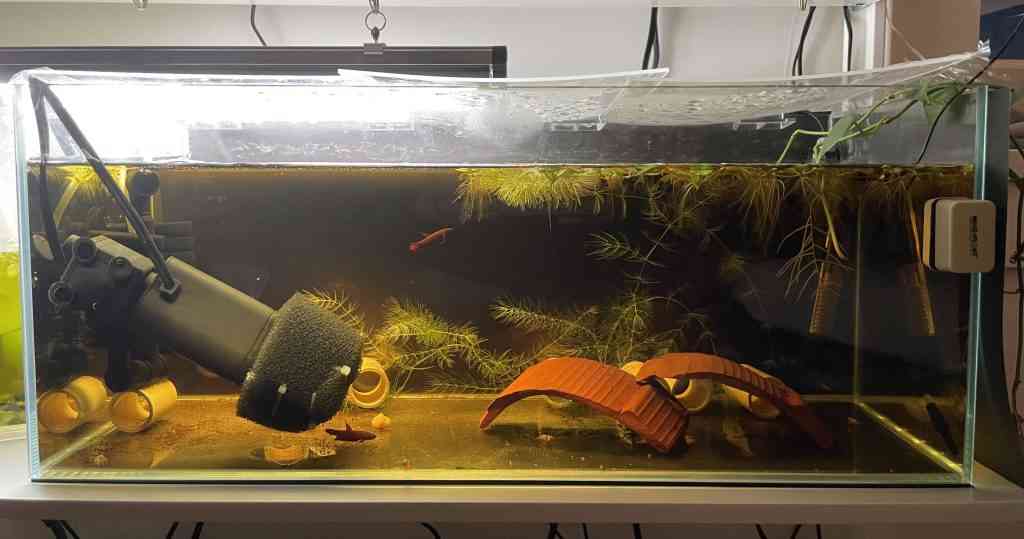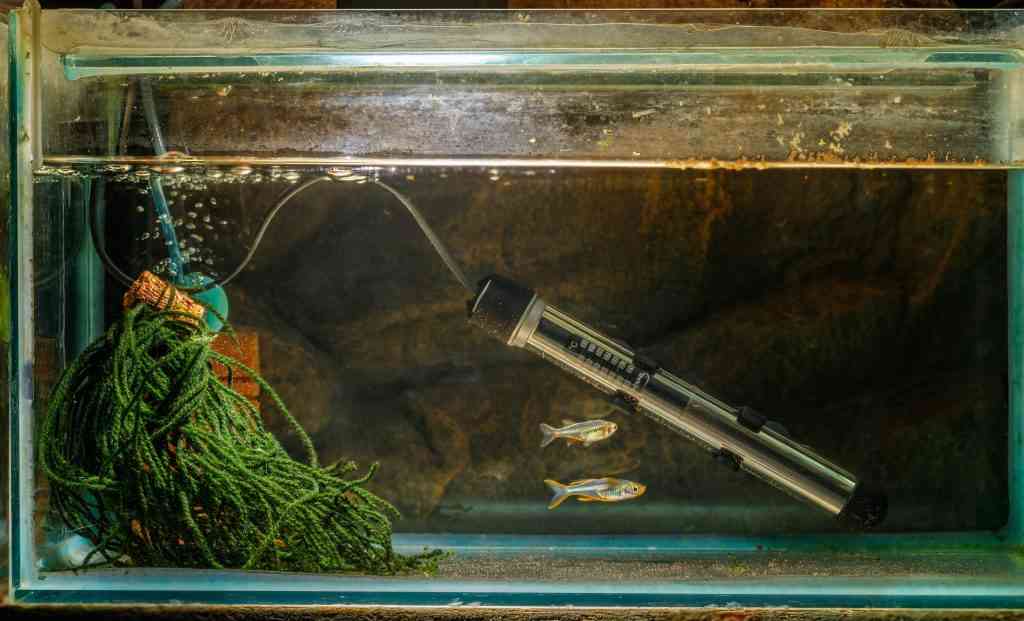Nora Hickey, D.V.M. & Jennifer O. Reynolds, M.A.
Jen and Nora explore the important practice of quarantining new home aquarium fish. They share their personal experiences and provide recommendations on when and how to quarantine, along with specific equipment suggestions.

Jen: Nora. It is time to talk about quarantine tanks. I have a feeling that while most aquarists would agree that quarantine is a good idea, far fewer of them actually do it. Guilty as charged over here. Working at the Aquarium was one thing—of course we had to quarantine and be professional about it. But I’ve been known to take some shortcuts at home. In fact, I now have my first home quarantine tank in use, and I feel really good about it. Why do fish vets recommend quarantine all the time? Can’t we just treat anything that shows up in our tanks?
Nora: You said it perfectly in our last conversation about external parasites, Jen. An ounce of prevention is worth a pound of cure (and sometimes that cure harms more than what it is treating). Fish veterinarians recommend quarantine because it protects the fish you currently have, and because it is often significantly easier and more effective to treat sick fish in a quarantine set up. There are quite a few infectious diseases that affect species of fish kept in home aquaria that are not treatable, in particular viruses and the notorious mycobacteria. And even if you introduce something treatable, like Ich, it can be challenging to properly treat it if you have an aquarium with species like catfish, which are sensitive to the common Ich treatments.
Jen: Your point about the ease and effectiveness of treatment is important. Some treatments don’t work as well in a tank full of plants and wood. I’d add to that the volume of treatment! A sad example I’ll have to admit to is having added one small betta to a hang-on tank on my large 108-gallon full of well-established bushfish (Ctenopoma spp.) who hadn’t had a disease in years (see pictures of this West African-inspired tank here). Guess who got an ich infestation! It was a lot more treatment I had to manage for 108 gallons, let alone having endangered all my large bushfish, now covered in unsightly white spots, than if I’d just stuck that little betta in a five gallon quarantine tank. Definitely a situation where I was rolling my eyes at myself. There is no doubt I should have known better. Something else we’ve talked about is which diseases or parasites we can gate-keep out of our aquariums with the use of quarantine and which should be considered ubiquitous or omnipresent and therefore “managed” for in the aquarium.
Nora: Great points. And to build upon the pain of treating established aquariums, some treatments can kill your biofilter. So it’s just never a situation that you want to get yourself into.
Jen: Yes, nuking your biofilter can result in a world of hurt for an established, fully-stocked aquarium.
Nora: It’s the stuff of nightmares.
Jen: Nitrite nightmares. Sounds like what a fishkeeper wakes up from in a cold sweat!
Nora: Yes, so let’s remind ourselves of what quarantine can do for us so that we don’t skip it ever again. There are quite a few infectious diseases that proper quarantine can keep out. The big ones I am thinking of are parasites such as Ich, which is probably the most common disease aquarium keepers run afoul of after unquarantined introductions. I will confess I have also introduced Ich into one of my tanks after skipping quarantine, so you and I are in good company, along with pretty much everyone else who has ever kept fish, probably.
Viruses are worth mentioning here. Megalocytivirus is a virus that pop up with some regularity in the ornamental trade, and it kills. You can’t treat viruses, so they are definitely something you want to keep out.
Jen: Yikes, I don’t know if I’ve run into that one. I was thinking about a lot of parasites, like anchorworm, Camallanus, gill flukes, skin flukes… so many that we can try to keep out, using quarantine.
Nora: Absolutely. So what did you do for your home quarantine tank you currently have set up?
Jen: Great question. So first it would be good to address why I didn’t just add the new bettas directly into the blackwater leaf litter aquarium I’d already established especially for them. The species that drove me to set up a tank for them was the Betta sp. ‘api api’, a gorgeous deep red coccina-complex betta from Riau in Indonesia.
In talking with my fish pro friends, they warned me that wild bettas are very susceptible to Piscinoodinium, better known as “Velvet”. They warned me that it happens to them very quickly, and that they noticed it tends to proliferate in tanks with leaf litter. My goal is definitely to keep these fish in a very natural, peat swamp-like habitat complete with the leaves. But had I introduced them right away into it, and if they got velvet, I’d probably be battling it for ages and would be stymied in my ability to treat.
My friends pointed out that any of the dye-type medications commonly used for this protozoan, like acriflavine, just get absorbed into organic materials like leaves, so it’s difficult to maintain an effective concentration. And aside from that, here in Canada we can barely get any of these drugs to treat! So I decided to quarantine them in a glass-bottom, leaf-less 10-gallon with some terracotta and PVC hides, a handful of floating plants and hornwort, and most importantly, a small UV filter to try to eradicate any velvet that might crop up. They’re two weeks into the planned month-long quarantine now, and they’re thriving.
Nora: Why are you quarantining these fish? What are you trying to keep out? Answering these questions is at the heart of any effective quarantine plan.
You’ve laid out something super simple but effective. You have a separate tank set up to hold the fish for one month, during which you will observe them for any signs of disease. If they seem fine at the end of one month, you will put them into their blackwater leaf litter paradise–and hopefully have no infectious disease problems!
Jen: There are loads of other advantages too. If I had to do a bath treatment for them, I could catch them easily. I think it would be nearly impossible to catch them out of the blackwater tank without destroying it in the process. Which would make both me and the newly established Cryptocorynes sad. Also, because they aren’t hiding in tannin-stained dark water with leaves, I can look at these small fish closely every day with my magnifier, to monitor for any visible parasites. Large water changes are easier, and it is easier to keep the bottom of the tank free of debris which could fuel parasites like Piscinoodinium or Epistylis.
Nora: These things you are describing are why I don’t have planted or heavily-landscaped tanks at all! Jen, how does this compare to what you had to do when quarantining new arrivals when you were a professional aquarist?
Jen: One of the big challenges we had in quarantine at the Aquarium when I was a professional was actually the large number and physical size of fish we had to handle. Large sharks, Arapaima, stingrays, catfish—they’re arriving at sizes that work for the big displays we had to stock. After all, no one visits to see a 12″ Arapaima, except maybe some of the geekier readers of this blog. But the quarantine tanks were much smaller than the displays the fish would eventually go into. So water quality was a big deal and we had to do large water changes sometimes on a daily basis. Also, we’d order in 300 cardinal tetras and quarantine them in a 75-gallon tank. Not the easiest.
On the other hand, we had a really good resource with our veterinarians, who could come and do skin scrapes or gill mounts for us on short notice, prescribe treatments and any fish that died in the group was usually sent off for histopathology. Those reports take time and sometimes more fish would die before we got them back. But they were often definitive in identifying the diseases, and we could learn over time what types of disease were most likely in the species we were bringing in, and based on the source they were coming from. In retrospect, I wish we’d had more access to UV filters. Budget issues are a reality in every setting, public aquariums included.
Nora: Yes, so let’s hone in on your UV treatment for the quarantine tank. I think it is brilliant.
Jen: It was great advice from my fish pro friends. And how lucky we are that small internal canisters with UV are available to hobbyists these days.
Nora: When I think of UV treatment, I think of large, expensive set ups. But you have this on a 10 gallon tank.
Jen: These little filters are usually sold to combat greenwater. And at the smaller sizes, it’s hard to be sure of the wattage and killing ability of the light and to be sure of the optimal flow rate for killing specific parasites. I’m sure it is better than nothing though, because with repeated passes of the tank water through the UV light, it is going to be killing organisms—if not perfectly, enough to help the fish not be overwhelmed. Nora, can you tell us a bit about how UV kills different diseases, and what hobbyists need to consider if they want to add one of these units to a quarantine tank?
Nora: UV can kill quite a few different pathogens, including select parasites, bacteria, fungi/water molds, and viruses. A UV unit runs a thin stream of water from the aquarium past a UV light bulb, exposing pathogens in the water to lethal doses of ultraviolet light. You are correct that different pathogens require different wattages and exposure times to ultraviolet light to be killed. Megalocytivirus is an example of a pathogen that is very vulnerable to UV, whereas certain water molds and parasites like Chilodonella are much more resistant.
UV is a very low-risk approach to reducing pathogen loads in your aquarium without using chemicals to treat the water. Public aquariums will sometimes do chemical treatments during quarantine to target certain pathogens, but I don’t think this is necessary for a home aquarium quarantine set up. A separate tank, watchful waiting, and patience should be more than sufficient–but having UV treatment is perfect for when you have something specific you are concerned about, or you’re going to be putting your fish into a particularly challenging-to-treat set up.
Jen: UV isn’t a requirement for an effective quarantine tank. Quarantine is recommended for so many reasons and like I said, we actually didn’t use it at the Aquarium in our quarantine systems. But I’d vouch for UV as a great addition and especially helpful for scenarios like I described above, where I’d much rather keep something out than be faced with trying to treat it. It’s also an effective addition to some established aquariums where you might be trying to treat or manage an existing disease, but we’ll tackle that in another conversation. A good quarantine tank has a few very specific elements to it. Let’s talk about what those are to help folks who are inspired to set one up for their next new fish.
Nora: Number one, a separate tank (that does not share water or equipment with your established aquarium).
Jen: Great reminder on keeping separate equipment. Definitely worth it to keep one siphon for a quarantine tank. Why go to all that trouble to set one up and then introduce the disease anyway with using the same hose!
Nora: And wash your hands in between working with different tanks, not just quarantine and established tanks.
Jen: Number two, no substrate. Keep the bottom glass or acrylic. Provide shelter for the fish’s psychological well-being with items that can be easily washed or sanitized like PVC, plastic, ceramic, rock. Calcium-based substrates can interfere with the dosing of copper, for example. This also helps you clean the bottom properly if you do end up with an ich outbreak or something where part of the life cycle occurs off of the fish’s body.
Nora: Agreed. Keep it as bare as possible, depending on the fish species. Your api api need those hiding places!
Jen: I’ve added floating plants to help uptake any ammonia and shelter them from bright light. If I need to treat anything though, I can easily chuck those out.
Nora: I think you bring up something I agree with you on, but may be controversial. It is okay to not have a cycled quarantine tank. You can keep an empty 10-gallon stashed in a closet somewhere and break it out when you have new arrivals. If you do large and frequent water changes, keep it lightly stocked, and don’t overfeed, it can fulfill its job for a month before you break it back down and stash it away again until you get your next new arrivals.
Jen: Indeed. And it’s also okay to use a filter or filter media from an established, healthy tank. I used to keep an extra, small sponge filter in one of my tanks for this purpose.
Nora: Yes! And number three, patience. Wait the entire amount of time you need to quarantine for—usually at least a month.
Jen: That is a tough one! I am so tempted to just put my api api in their blackwater tank now because they seem fine, but seeming fine is not the same as knowing that I’ve waited the right amount of time to observe any parasite’s potential life cycle. Besides, fish need time to recover from the stress of shipping, where they’re more susceptible to any disease they encounter. It will be an additional stress for them to be handled and moved to yet another tank, so it’s best to wait a month, which is standard in professional institutions.
Number four, have a plan for how you will treat some of the common diseases if they do occur. Some people keep a stock of different medications on hand, but I think having a plan for how to acquire the meds in a timely fashion is also fine. Medications can expire if kept around too long, anyway. I do keep salt on hand though, as so many diseases can be treated with it and it is a low stress intervention for the fish. It’s also a good idea to avoid using carbon in a quarantine tank, or at least be able to remove it quickly if you do use a medication that could be adsorbed by carbon. Having carbon available to add after the end of a treatment can be useful.
Nora: Great point. Different species of fish are more likely to get certain diseases, so while you can’t prepare for everything, you can be prepared for the likely suspects. Velvet for api api, Tetrahymena for guppies, Ich for every fish species ever….
I don’t think there is much more to quarantine than that. And now let’s promise each other that the next new arrivals we get, we will quarantine.
Jen: You know I will! My local fish store gave me the 10-gallon for free with their points system, so I’ve really got no excuse now.

